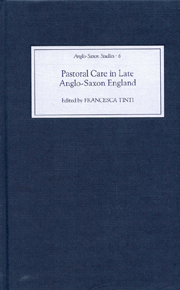Book contents
- Frontmatter
- Contents
- List of illustrations
- List of contributors
- Abbreviations
- Introduction
- 1 The clergy in English dioceses c. 900–c. 1066
- 2 The ‘costs’ of pastoral care: church dues in late Anglo-Saxon England
- 3 Ælfric in Dorset and the landscape of pastoral care
- 4 Is there any evidence for the liturgy of parish churches in late Anglo-Saxon England? The Red Book of Darley and the status of Old English
- 5 Remedies for ‘great transgressions’: penance and excommunication in late Anglo-Saxon England
- 6 The pastoral contract in late Anglo-Saxon England: priest and parishioner in Oxford, Bodleian Library, MS Laud Miscellaneous 482
- 7 Caring for the dead in late Anglo-Saxon England
- Index
2 - The ‘costs’ of pastoral care: church dues in late Anglo-Saxon England
Published online by Cambridge University Press: 12 September 2012
- Frontmatter
- Contents
- List of illustrations
- List of contributors
- Abbreviations
- Introduction
- 1 The clergy in English dioceses c. 900–c. 1066
- 2 The ‘costs’ of pastoral care: church dues in late Anglo-Saxon England
- 3 Ælfric in Dorset and the landscape of pastoral care
- 4 Is there any evidence for the liturgy of parish churches in late Anglo-Saxon England? The Red Book of Darley and the status of Old English
- 5 Remedies for ‘great transgressions’: penance and excommunication in late Anglo-Saxon England
- 6 The pastoral contract in late Anglo-Saxon England: priest and parishioner in Oxford, Bodleian Library, MS Laud Miscellaneous 482
- 7 Caring for the dead in late Anglo-Saxon England
- Index
Summary
Through the diligence of our legates, baptismal churches are ordered to be restored by those who are baptised or receive their sacraments [there], and it should be entrusted to the public administrators that through their insistence the children of the church be compelled to their restoration and obliged to give tithes to God there.
This passage from Emperor Lothar's Capitulare missorum of 832 establishes a very specific and explicit relationship between the delivery of pastoral care and the obligation on the part of the recipients to pay tithes in return for it and to participate in the restoration of the church from which they receive their sacraments. The direct relation between the reception of cura animarum and the payment of church dues represents an important and recurrent aspect of Carolingian legislation on tithes.
Although in the Old Testament and in the early history of Christianity tithes were considered the special property of God, it soon became canonically accepted that they could be used for the support of the poor and the repair of churches. Originally, the bishops and clergy who controlled such payments were not even entitled to a share, but with the development of a territorial ecclesiastical organisation, new elements began to appear. For instance, in 722 Pope Gregory II wrote a letter to Bishop Boniface in Thuringia (a region which was still missionary land), specifying that he had to divide the revenue of the church and the offerings of the faithful into four parts: one for Boniface himself (i.e. the bishop); one for the clergy; a third part for the poor; and the last part for the maintenance of ecclesiastical buildings.
- Type
- Chapter
- Information
- Pastoral Care in Late Anglo-Saxon England , pp. 27 - 51Publisher: Boydell & BrewerPrint publication year: 2005



